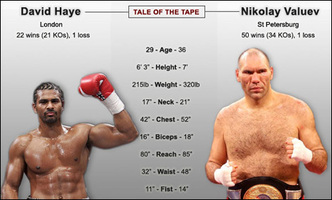
The heavyweight division is quite different from other divisions in boxing as no upper weight limit exists for fighters. In other weight categories a new division is created every 3lbs to 8lbs. Only within the cruiserweight division is there a potentially larger gap (175lbs to 200lbs).
Boxing currently has a significant 17 weight categories. The newest of which is the minimum-weight (Straw-weight or mini flyweight) division introduced in 1987. Before this new division, the most interesting introduction, was the cruiserweight division in 1980 when a upper weight limit of 195lbs was set and later extended to 200lbs. Before the introduction of the Cruiserweight division Heavyweights were fighters above the Light-Heavyweight limit of 175lbs.
A quick scan of the data from the 50’s, 60’s and 70’s, suggests why such a division was introduced. The average weight of heavyweight contenders and champions in 1954 was 86kg. By 1984 that had increased to 110kg. Due to an increase in the size of competitors, the cruiserweight division was introduced as a matter of competitive parity. Boxing was now making structural changes based on fairness. Smaller men should not have to compete against bigger men. The result of the cruiserweight division was that the Heavyweight division was now only available to fighters over 195lbs and later 200lbs. The crux of the problem however remains; as there is no upper limit for Heavyweights, smaller Heavyweights still have to fight much larger opponents.
The most successful heavyweight clash, at least financially, of the last number of years was undoubtedly Wladimir Klitschko v David Haye that took place in Hamburg in 2011. The disparity in size, in what was considered Klitschko’s
biggest challenge to date, was enormous in boxing terms. Weighing in at 242lbs, Klitschko was 30lbs heavier than Haye. Coupled with a height and reach advantage, the result was not surprising. Haye’s next fight is against an even larger opponent, Tyson Fury, who weighs in excess of 255lbs and is 6 foot 9 inches.
Putting it in terms of other divisions it is the equivalent of a Super-Middleweight (perhaps somebody like Carl Froch) fighting a Lightweight or even Super-Featherweight. I think most boxing analysts would agree that the size, height, power and reach advantage that a super-middleweight would have would simply be too much. So why is it ok for the heavyweight division to allow such disparities? And why would a fighter such as Haye, who was a dominant cruiserweight, want to be a Heavyweight against a much larger opponent?
In short, the risk is easily off-set by the financial reward, with Haye making a reported £15 million for the Klitschko fight and potentially £5 million to fight Tyson Fury. This far exceeds any potential earnings Haye would get at cruiserweight.
Since its introduction the Crusierweight division has been seen primarily as a training ground for future heavyweights and has, as a result, garnered very little respect in boxing circles, relative to other weight categories. It also highlights the financial incentives to become a heavyweight even if the risk is greater at heavyweight. All cruiserweight champions who have fought the Klitschkos in recent years have lost; Thomas Adamek, Jean Marc Mormeck and David Haye. Arguably, the cruiserweights most notable champion, Evander Holyfield, is primarily remembered as the Heavyweight he became. The general public, I would imagine, would only remember him as a heavyweight such is the lack of notoriety the cruiserweight division holds.
Is a Super Heavyweights division an answer?
One solution mooted to combat the disparity between Heavyweight competitors is the introduction of a Super Heavyweight division. Perhaps an upper limit of 225/230lbs. But I feel this will further dilute the value of the Heavyweight division. I would also argue that there is a case for diminishing returns when it comes to weight in the Heavyweight division. Bigger fighters are not always better fighters. Larger weights can often lead to poorer performances. The biggest champion ever of the division, Nikolai Valuev, would be a prime example of where size does not always equate to dominance. This point is also highlighted by the fact Haye is a firm favourite to beat Fury based on his record and ability.
Perhaps more of a promotion, by broadcasters and promoters alike, of the cruiserweight division would be of better value to boxing.
One of many such examples, in what is regarded as one of the greatest heavyweight fights of all-time, saw Rocky Marciano overcome Jersey Joe Walcott in 1952 in their first meeting. If that fight were to take place today, the fight would be in the cruiserweight division. Nobody could argue that the fight would be less significant because of this. However the perception that it’s for the heavyweight title may make it more valuable in peoples mind. And that is the problem for the cruiserweight division and more importantly smaller heavyweights. The public, that dictates the success of fights through ticket sales, pay per view purchases and TV numbers, simply have a bias towards Heavyweight fights.
 RSS Feed
RSS Feed